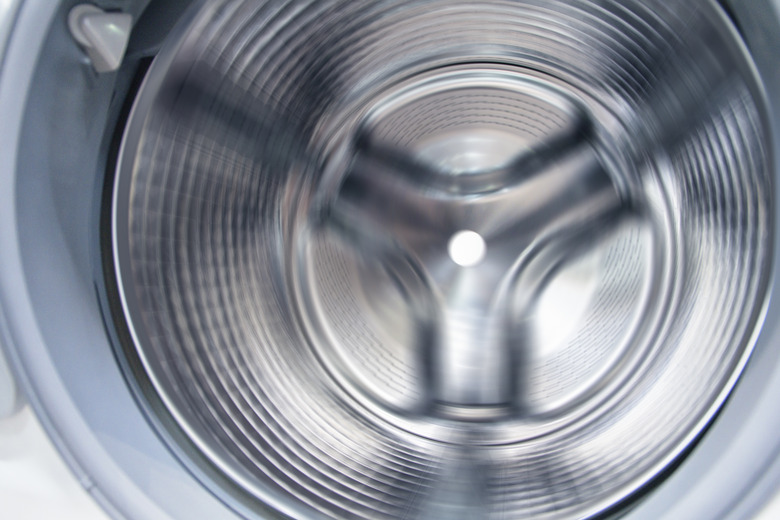Homemade Spin Dryer
At the end of your washing machine's cycle, you have a pile of wet clothes and need a way to dry them. There are a few different ways to accomplish this task. Most people tend to use tumble dryers or a clothesline. You could also buy or build a spin dryer. These small devices have less capacity compared to a tumble dryer, but take less electricity and dry clothes more quickly than a clothesline.
Building the Dryer
Step 1
Unscrew the lid from your 3-gallon bucket. Remove any stickers or plastic covering the bucket.
Step 2
Make a mark about 1 inch from the bottom of the bucket. Turn the bucket and make a second mark about 1 inch from that. Repeat until you have a row of marks, then move 1 inch down and repeat. Cover the bucket with these marks.
Step 3
Drive a nail through the body of the bucket at one of the points you have marked. Remove the nail, wiggling it to widen the gap a much as possible while you take it out. Repeat with all of the remaining holes.
Step 4
Cut a 1-by-2-inch plank so that it fits snugly into the bottom of the bucket. Make two pieces. Push one piece into the bottom of the bucket.
Step 5
Screw through the side of the bucket into the piece of wood at both ends.
Step 6
Place the second piece of wood on the underside of the bucket, so that it's in the same position as the first. Screw this piece of wood into the first. Place screws so they run from the inside of the bucket to the outside, and vice versa. Don't screw into the center of the bucket.
Step 7
Drill through the center of the bucket, and through the two wood planks. Use a ruler to measure the exact center, and use a bit wide enough to accommodate the bolt.
Step 8
Push the bolt through the bottom of the bucket, so it points away from the bottom of the bucket. Bolt it into place as tightly as possible using the drill and wrench to tighten the bolt.
Step 9
Drive a nail through the lid of the bucket in the exact center. Measure to find this center. The nail should go from the underside of the lid through to the top.
Step 10
Cut two 3-inch 1-by-2 planks. Drive the nail in the lid through the center of one piece, and all the way through the other side.
Step 11
Apply caulk to the nail and bolt heads. Make sure both metal pieces are level and perpendicular to the bucket. Leave the caulk to dry overnight.
Step 12
Place the second 3-inch piece of wood across the bottom of the lid, so that it matches the position of the first. Screw this piece of wood into place, so that it holds the nail in place. Again, put screws from the outside in, and from the inside pointing outward.
Step 13
Remove the bit from the drill, and clamp the drill onto the bolt sticking out the bottom of the barrel.
Using the Dryer
Step 1
Load the dryer with some wet clothes. On your first few attempts, begin with smaller loads to determine what kinds of speeds your dryer can handle.
Step 2
Screw the lid onto the bucket.
Step 3
Place the nail in the bottom of the 5-gallon bucket, lined up in the center of the container.
Step 4
Hold the drill and inner bucket level, and switch on the drill. Pull the drill trigger slowly to start increasing the speed at which the inner bucket spins. Water will begin to flow out of the holes you nailed in the side.
Step 5
Remove the inner bucket from the container. Lift by the lid (on the bottom) of the bucket. Unscrew the lid and remove your clothes. Spin-drying may not get everything completely dry on the first use. So, rearrange the clothes inside and spin again.
Things Needed
- 3-gallon plastic bucket or tall cylindrical container with screw-on lid
- Marker
- Ruler
- Claw hammer and thick nail
- 1-by-2-inch wood plank
- Saw
- 2-inch screws
- Power drill
- 6-inch metal bolt and nut set
- Wrench
- 3-inch nail
- Caulk or waterproof adhesive
- Level
- 5-gallon bucket
- Corded power drill (optional)
TL;DR (Too Long; Didn't Read)
A corded power drill generally has more power, and may succeed in getting your clothes dryer than a battery-operated drill.
References
Cite This Article
MLA
Turner, Grahame. "Homemade Spin Dryer" sciencing.com, https://www.sciencing.com/homemade-spin-dryer-7980447/. 24 February 2011.
APA
Turner, Grahame. (2011, February 24). Homemade Spin Dryer. sciencing.com. Retrieved from https://www.sciencing.com/homemade-spin-dryer-7980447/
Chicago
Turner, Grahame. Homemade Spin Dryer last modified March 24, 2022. https://www.sciencing.com/homemade-spin-dryer-7980447/
